1、目标
将下图中的鹰从图中分割出来
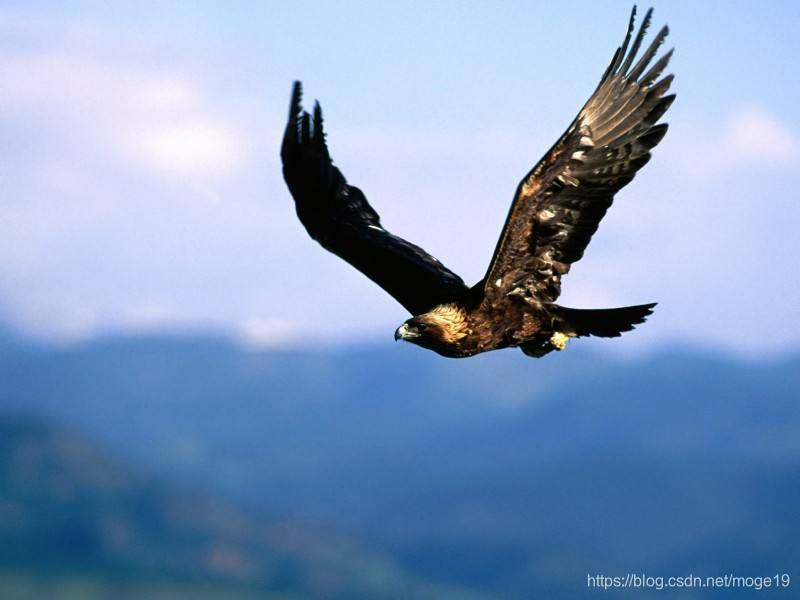
2、步骤
2.1 加载图片,进行灰度化
img_path = "bird.jpg"
img = cv2.imread(img_path)
gray = cv2.cvtColor(img, cv2.COLOR_BGR2GRAY)
cv2.imshow("img",gray)
2.2 对图片进行滤波,去掉不必要的像素点
gray = cv2.cvtColor(img, cv2.COLOR_BGR2GRAY)
blurred = cv2.GaussianBlur(gray, (9, 9),0)
img2 = gray-blurred
cv2.imshow("img2",img2)
结果:
图片中相应的轮廓已经很清晰了,但是还需要去掉不相干的黑点。
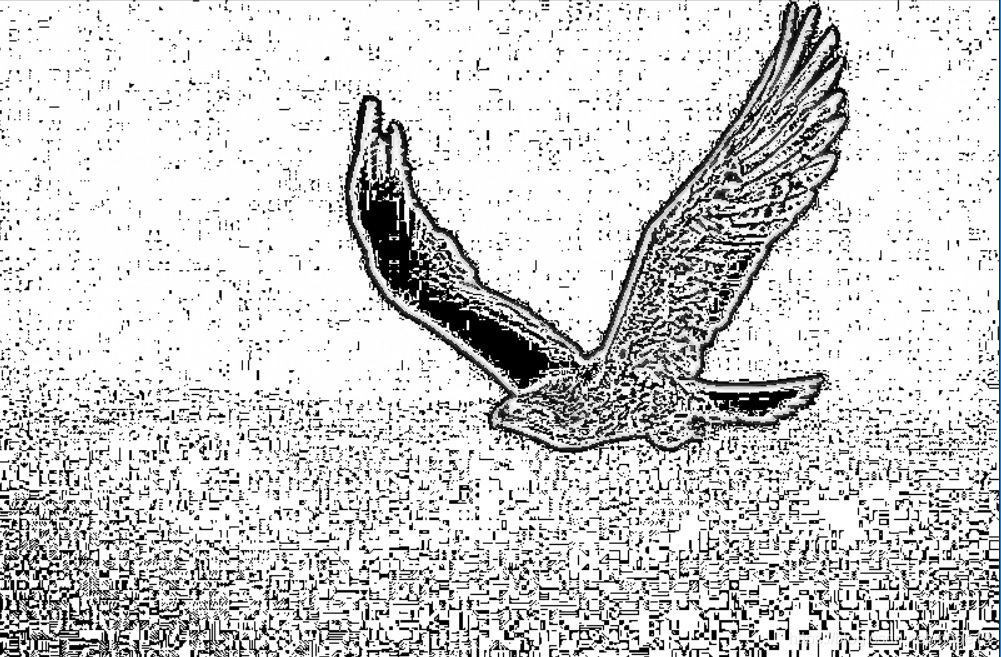 2.3、再次滤波
2.3、再次滤波
blurred = cv2.GaussianBlur(img2 , (9, 9),0)
(_, thresh) = cv2.threshold(blurred, 90, 255, cv2.THRESH_BINARY)
cv2.imshow("img3",thresh)
结果:
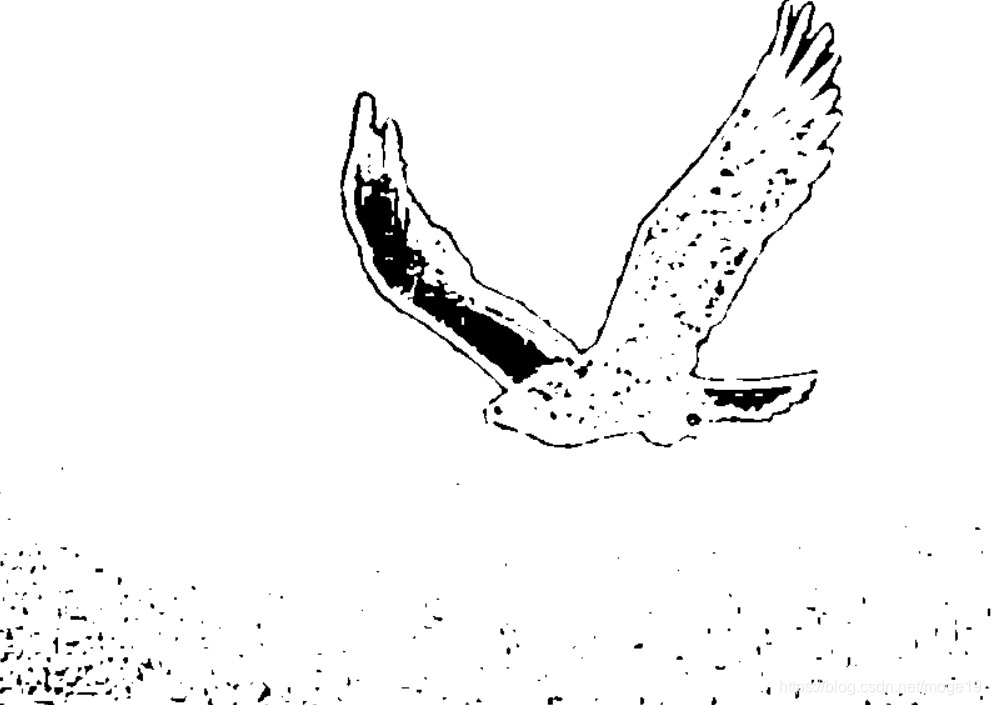 2.4 图像的关键点边迹已成雏形了,现在需要进行聚类,这里我们选择DBSCAN算法,居于密度的聚类,算法实现:
2.4 图像的关键点边迹已成雏形了,现在需要进行聚类,这里我们选择DBSCAN算法,居于密度的聚类,算法实现:
主要步骤:
(1)取出黑色像素点的在图片中的坐标;
(2)利用DBSCAN算法对坐标值进行聚类;
(3)取出目标物体的聚类。
size_x = thresh.shape[0]
size_y = thresh.shape[1]
picture_data = np.array(thresh)
Pic_Data = []
#记录为黑色素像素点的为者
for i in range(size_x):
for j in range(size_y):
if picture_data[i][j] == 0:
Pic_Data.append([i,j])
#plt.plot(i,j,'o')
X=np.array(Pic_Data)
size=len(X)
y_pred = DBSCAN(eps = 40, min_samples = 10).fit_predict(X)
#plt.plot(X[0:size,1],X[0:size,0],'o')
Pic_Data_1 = []
for k in range(len(X)):
if(y_pred[k]==0):
Pic_Data_1.append(Pic_Data[k])
X=np.array(Pic_Data_1)
plt.plot(X[:, 0], X[:, 1],'o')
plt.show()
用plt.plot函数显示的结果:

2.5 根据聚类结果从原图中取出目标物体
二值图像如下图所示:
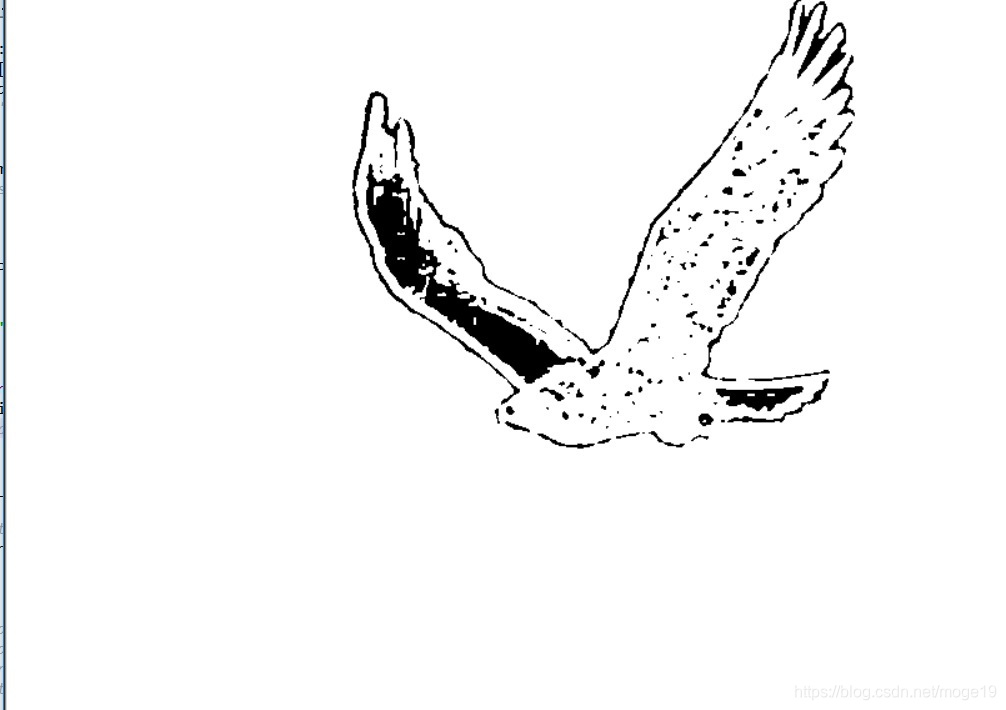
2.6 图像形态学
kernel = cv2.getStructuringElement(cv2.MORPH_ELLIPSE, (64, 64))
closed = cv2.morphologyEx(thresh, cv2.MORPH_CLOSE, kernel)
cv2.imshow("img5",closed)
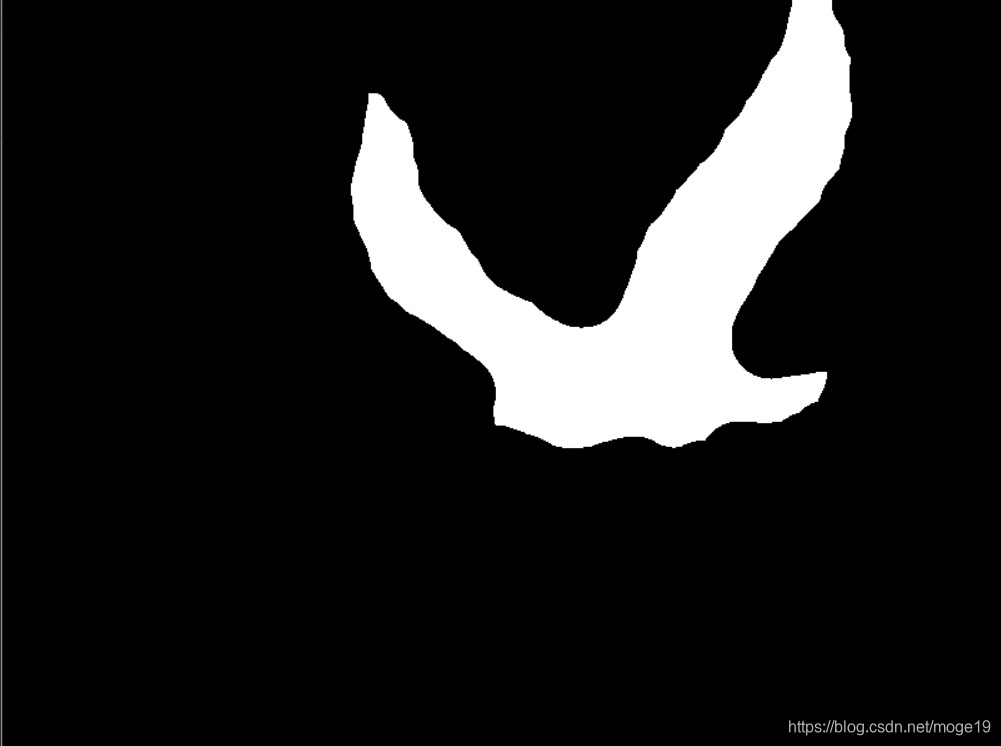 2.7 细节刻画
2.7 细节刻画
closed = cv2.erode(closed, None, iterations=16)
closed = cv2.dilate(closed, None, iterations=16)
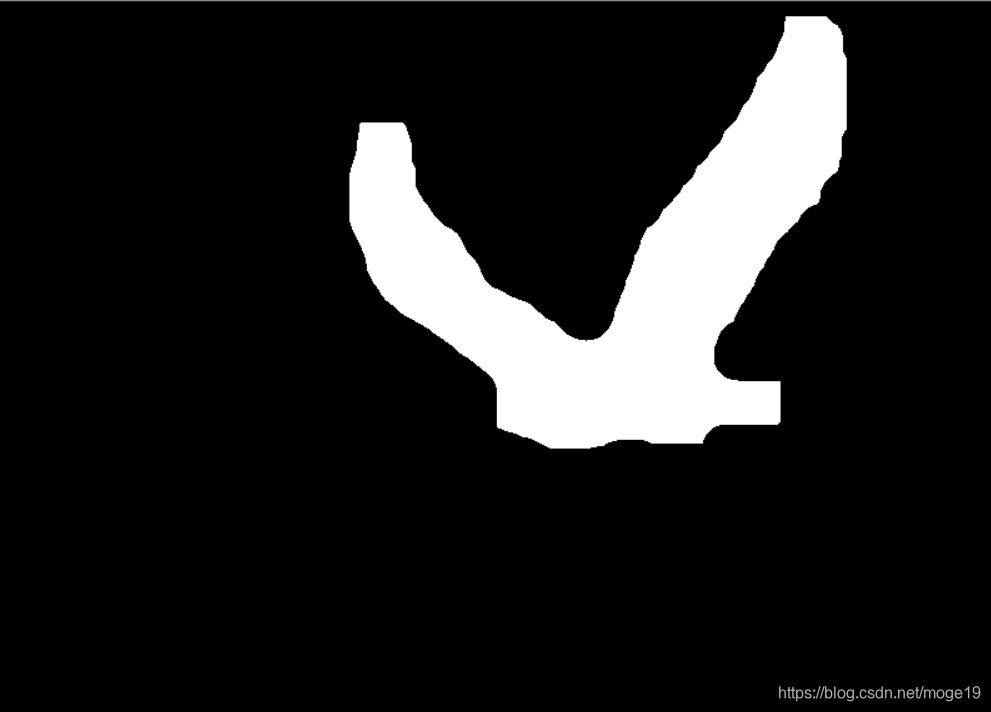 2.8 找出鹰的轮廓
2.8 找出鹰的轮廓
def findcnts_and_box_point(closed):
# 这里opencv3返回的是三个参数
(_, cnts, _) = cv2.findContours(closed.copy(),
cv2.RETR_LIST,
cv2.CHAIN_APPROX_SIMPLE)
c = sorted(cnts, key=cv2.contourArea, reverse=True)[0]
# compute the rotated bounding box of the largest contour
rect = cv2.minAreaRect(c)
box = np.int0(cv2.boxPoints(rect))
return box
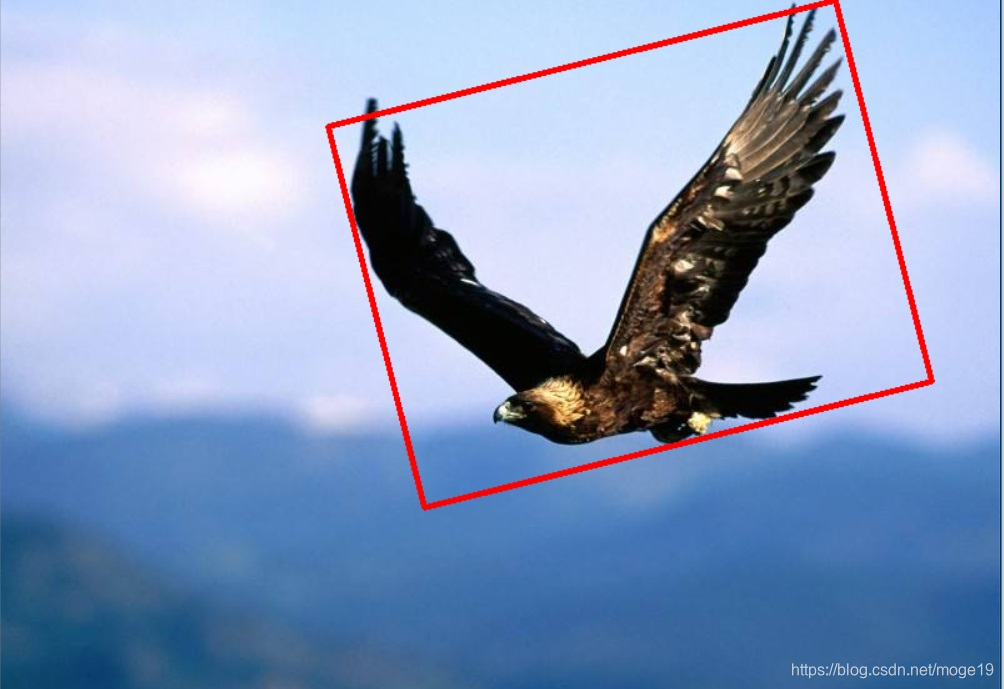
参考源码
在该博文(https://blog.youkuaiyun.com/sinat_36458870/article/details/78825571)提供的源码基础上进行了修改
import numpy as np
import cv2
from PIL import Image
from scipy import ndimage
import matplotlib.pyplot as plt
from sklearn.cluster import DBSCAN
def findcnts_and_box_point(closed):
# 这里opencv3返回的是三个参数
(_, cnts, _) = cv2.findContours(closed.copy(),
cv2.RETR_LIST,
cv2.CHAIN_APPROX_SIMPLE)
c = sorted(cnts, key=cv2.contourArea, reverse=True)[0]
# compute the rotated bounding box of the largest contour
rect = cv2.minAreaRect(c)
box = np.int0(cv2.boxPoints(rect))
return box
def drawcnts_and_cut(original_img, box):
# 因为这个函数有极强的破坏性,所有需要在img.copy()上画
# draw a bounding box arounded the detected barcode and display the image
draw_img = cv2.drawContours(original_img.copy(), [box], -1, (0, 0, 255), 3)
Xs = [i[0] for i in box]
Ys = [i[1] for i in box]
x1 = min(Xs)
x2 = max(Xs)
y1 = min(Ys)
y2 = max(Ys)
hight = y2 - y1
width = x2 - x1
crop_img = original_img[y1:y1+hight, x1:x1+width]
return draw_img, crop_img
def image_morphology(thresh):
# 建立一个椭圆核函数
kernel = cv2.getStructuringElement(cv2.MORPH_ELLIPSE, (48, 48))
# 执行图像形态学, 细节直接查文档,很简单
closed = cv2.morphologyEx(thresh, cv2.MORPH_CLOSE, kernel)
closed = cv2.erode(closed, None, iterations=4)
closed = cv2.dilate(closed, None, iterations=4)
return closed
def Thresh_and_blur(gradient):
blurred = cv2.GaussianBlur(gradient, (9, 9),0)
(_, thresh) = cv2.threshold(blurred, 90, 255, cv2.THRESH_BINARY)
return thresh
img_path = r'E:\my_project\bird.jpg'
original_img = cv2.imread(img_path)
gray=cv2.cvtColor(original_img,cv2.COLOR_BGR2GRAY)
blurred = cv2.GaussianBlur(gray, (9, 9),0)
img2 = gray-blurred
blurred = cv2.GaussianBlur(img2, (9, 9),0)
(_, thresh) = cv2.threshold(blurred, 90, 255, cv2.THRESH_BINARY)
size_x = thresh.shape[0]
size_y = thresh.shape[1]
picture_data = np.array(thresh)
Pic_Data = []
#记录为黑色素像素点的为者
for i in range(size_x):
for j in range(size_y):
if picture_data[i][j] == 0:
Pic_Data.append([i,j])
#plt.plot(i,j,'o')
X=np.array(Pic_Data)
size=len(X)
y_pred = DBSCAN(eps = 40, min_samples = 10).fit_predict(X)
#plt.plot(X[0:size,1],X[0:size,0],'o')
Pic_Data_1 = []
for k in range(len(X)):
if(y_pred[k]==0):
Pic_Data_1.append(Pic_Data[k])
X=np.array(Pic_Data_1)
plt.plot(X[:, 0], X[:, 1],'o')
plt.show()
Test_Pic = [[255 for i in range(size_y)] for j in range(size_x)]
Test_Pic = np.array(Test_Pic)
#X=np.array(Pic_Data_1,dtype=np.uint8)
for X_Index in X:
Test_Pic[X_Index[0]][X_Index[1]]=0
thresh=np.array(Test_Pic,dtype=np.uint8)
gray = thresh
gradX = cv2.Sobel(gray, ddepth=cv2.CV_32F, dx=1, dy=0)
gradY = cv2.Sobel(gray, ddepth=cv2.CV_32F, dx=0, dy=1)
gradient = cv2.subtract(gradX, gradY)
thresh = gradient
thresh = Thresh_and_blur(gradient)
kernel = cv2.getStructuringElement(cv2.MORPH_ELLIPSE, (40, 40))
closed = cv2.morphologyEx(thresh, cv2.MORPH_CLOSE, kernel)
closed = cv2.erode(closed, None, iterations=16)
closed = cv2.dilate(closed, None, iterations=16)
#closed = image_morphology(thresh)
closed = np.array(closed,np.uint8)
box = findcnts_and_box_point(closed)
draw_img, crop_img = drawcnts_and_cut(original_img,box)
cv2.imshow('original_img', original_img)
cv2.imshow('blurred', blurred)
cv2.imshow('gradX', gradX)
cv2.imshow('gradY', gradY)
cv2.imshow('final', gradient)
cv2.imshow('thresh', thresh)
cv2.imshow('closed', closed)
cv2.imshow('draw_img', draw_img)
cv2.imshow('crop_img', crop_img)
cv2.waitKey(200)








 本文介绍了一种基于图像处理和机器学习的方法,用于从复杂背景中精确分割和识别特定目标——鹰。首先通过灰度化、滤波和二值化等预处理步骤增强图像对比度,然后使用DBSCAN聚类算法定位目标轮廓,最后应用图像形态学操作细化边界并提取目标区域。
本文介绍了一种基于图像处理和机器学习的方法,用于从复杂背景中精确分割和识别特定目标——鹰。首先通过灰度化、滤波和二值化等预处理步骤增强图像对比度,然后使用DBSCAN聚类算法定位目标轮廓,最后应用图像形态学操作细化边界并提取目标区域。
















 310
310

 被折叠的 条评论
为什么被折叠?
被折叠的 条评论
为什么被折叠?








